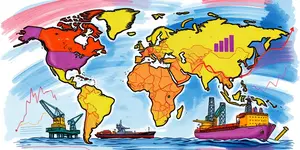
In a world defined by constant change, understanding the pulse of global M&A can unlock opportunities for growth and resilience. As companies recalibrate strategies in response to shifting markets, the surge and ebb of dealmaking tell a story of ambition, caution, and innovation.
In the first half of 2025, global M&A volumes decreased by 9% compared to the prior year. Yet, beneath the surface, diverse regional dynamics and sector-specific forces reveal optimism for those prepared to adapt.
Today’s environment is shaped by several overarching factors:
Regional investment patterns in H1 2025 underscored divergent strategies. While overall deal volume dipped, deal value concentrated in growth-oriented markets.
Key highlights by region include:
Sector activity painted a complementary narrative. Consumer markets saw a 9% decline in volume but are poised for rebound as companies undertake strategic transformations. Meanwhile, large deals spiked in May 2025, with five transactions totaling $82 billion—an astounding 272% increase year-over-year.
As organizations pursue transformative deals, success hinges on robust frameworks that address both risk and opportunity:
Technological advancements play an ever-greater role. From AI-driven target screening to predictive analytics for integration planning, companies that embrace digital tools often outpace peers in speed and precision.
Despite present uncertainties, industry leaders anticipate a revival in deal volume over the next year. Three themes promise to guide the next wave of M&A:
1. Sustainable Growth: Increased investor scrutiny on environmental, social, and governance factors will drive transactions that bolster supply chain resilience and ethical practices.
2. Tech-Enabled Expansion: Companies will leverage digital platforms and AI to target acquisitions in emerging technology segments—from fintech to clean energy—that offer outsized growth.
3. Cross-Border Realignment: As geopolitical landscapes shift, firms will seek deals that enhance regional presence, diversify risk, and secure critical resources.
For M&A professionals, the path forward lies in balancing bold vision with disciplined execution. By integrating advanced analytics, cultivating strategic partnerships, and prioritizing sustainable value creation, organizations can turn market complexity into competitive advantage.
To capitalize on the evolving M&A environment, consider these actionable insights:
These foundational measures empower companies to identify high-potential targets, negotiate from a position of strength, and navigate post-deal complexities with confidence.
The first half of 2025 has underscored both the challenges and promise of global M&A. While volumes have softened, deal values and strategic realignments reveal a resilient landscape where innovation flourishes.
By staying attuned to regional shifts, harnessing technological advancements, and deploying disciplined integration strategies, dealmakers can uncover opportunities that drive growth. In this era of dynamic transformation, spotting companies on the move means embracing agility, foresight, and an unwavering commitment to value creation.
As markets evolve, the most successful organizations will be those that view M&A not merely as transactions, but as catalysts for enduring progress.
References













